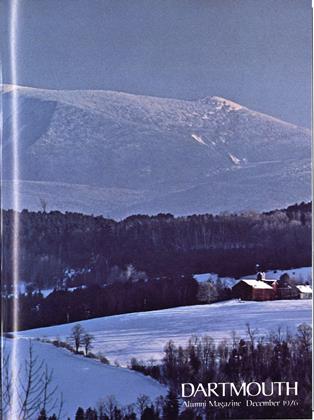APPLIED to Dartmouth undergraduates, the words grate with incongruity. A more imprecise evocation of the Dartmouth image would be difficult to conjure up. Nevertheless, the Hanover Plain has witnessed over two centuries an astonishing spectrum of student fashion, North Country style, from the knee breeches of Eleazar Wheelock's pupils (above) to the übiquitous Levis of today; from flowing ties to no ties at all; from high-button boots to hiking boots.
Where tailcoat and cutaway were de rigueur at the turn of the century for the college man weekend-bound, today's undergraduate can stow a month-long wardrobe in a backpack, with only a rumpled shirt and tie or a nylon skirt to accommodate the formality demanded of any occasion. But themes recur. Turtlenecks come and go; wool caps are always good; pipes have consistently projected the casual masculine air.
There are regional nuances. Dartmouth students favor the rugged look, a sort of studied dishevilment, in contrast to the careless insouciance of effete neighbors to the south. Overcoats have always been frowned on, and this season the down vest has all but abolished sleeves, except for the frail.
Campus fashion tends to be writ large. Hair is worn longer, or shorter, than elsewhere; skirts shrink briefer or droop longer; even raccoon coats seemed furrier. Give an undergraduate a trend, and he'll manufacture a fad. When saddle shoes were in, Spauldings were indispensable; if tennis shoes were the thing, only Wimbledons would do. Who ever heard of a moccasin but Bass Weejun, a track shoe other than Adidas? In backpacks, Kelty is a must; the sleeping bag requires a sufficiency of down to insulate at -20 degrees, no matter it will be used only to crash on a friend's couch.
We offer no sociological musings on the significance of campus dress as commentary on the society it reflects or rejects. We present only a collage of Dartmouth students in all their finery - or unrefinery - not as their mothers might want them to be, but as they were and are.
What the young gentlemen wore: for a stroll about campus in 1872, observing football practice in the 1950s, or for an arrest in 1969.
What the young gentlemen wore: for a stroll about campus in 1872, observing football practice in the 1950s, or for an arrest in 1969.
What the young gentlemen wore: for a stroll about campus in 1872, observing football practice in the 1950s, or for an arrest in 1969.
Features
-
 Feature
FeatureA Cultural Look Ahead
MAY 1957 -
 Feature
FeatureAcademic Centers
April 1975 -
 Feature
FeatureA Spot of Green at Knob Lake
March 1958 By ALAN COOKE '55 -
 Feature
FeatureOMBUDSMAN
OCTOBER 1971 By MARY ROSS -
 Cover Story
Cover StoryTHE FATHER OF CHAOS
JUNE 1990 By Steve Lyons -
 Feature
FeatureReels, Jigs, and Hornpipes
April 1974 By THOMAS W. SHERRY








